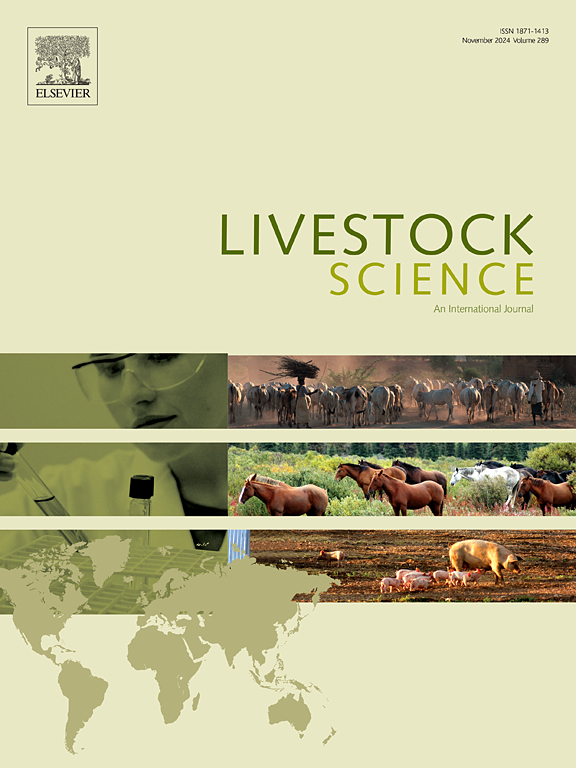Effects of dry matter concentration in grass silage on milk production of dairy cows fed concentrates high or low in metabolizable protein concentration
IF 1.8
3区 农林科学
Q2 AGRICULTURE, DAIRY & ANIMAL SCIENCE
引用次数: 0
Abstract
Studies have shown that extended wilting of grass before ensiling can improve the metabolizable protein (MP) value of the grass silage, both from increased rumen microbial crude protein (MCP) yield and ruminally undegraded crude protein (RUP). We hypothesised that extending the wilting of grass before ensiling can increase milk and milk protein production in dairy cows. Consequently, increased silage MP can reduce the need for MP in concentrate, estimated as amino acids absorbed in the small intestine (AAT20). To test this, a continuous feeding experiment was conducted, with 48 early- to mid-lactation Norwegian Red dairy cows. Treatments were 2 wilting levels of grass silages: 260 vs. 417 g dry matter (DM) per kg, and 2 qualities of concentrates differing in MP, in a 2 × 2 factorial arrangement (n = 12). The concentrates were low MP (LMP); 104 g AAT20/kg DM, and high MP (HMP); 123 g AAT20/kg DM, supplied at 8.75 kg DM/cow per day. The cows had ad libitum access to the grass silages. The experiment lasted for 11 weeks. The first 2 weeks, where cows received identical diets, were used as the covariate period. Those data together with data collected the last 4 weeks were used for statistical evaluation of treatments. Increasing DM concentration in silage reduced lactic acid, ammonia nitrogen and proportion of methionine in the grass silage, while it increased residual water-soluble carbohydrates, pH, proportion of aspartic acid and rumen degradability of NDF. There was no difference between treatments in daily silage DM intake (13.1 kg), milk yield (30.2 kg) or milk composition. However, feeding HMP increased urea and uric acid in urine, and urea in blood plasma, thereby reduced N efficiency. No major differences were found for rumen pH, or purine derivatives to creatinine index in urine, as indication for MCP. There was significantly more histidine in blood plasma when cows were fed HMP concentrate. In conclusion, increased DM concentration in silage and HMP concentrate did not increase milk production or milk protein yield in this study.
草青贮干物质浓度对饲喂高或低代谢蛋白精料奶牛产奶量的影响
研究表明,青贮前延长牧草萎蔫期可以提高牧草青贮的代谢蛋白(MP)值,包括瘤胃微生物粗蛋白(MCP)产量和瘤胃未降解粗蛋白(RUP)产量。我们假设在青贮前延长草的枯萎期可以增加奶牛的牛奶和乳蛋白产量。因此,青贮MP的增加可以减少精料中对MP的需求,以小肠吸收的氨基酸(AAT20)估算。为了验证这一点,采用48头泌乳早期至中期的挪威红奶牛进行了连续饲养试验。按2 × 2因子排列(n = 12),处理两种枯蔫水平的青贮草:每公斤260 g和417 g干物质(DM),以及两种不同品质的浓缩料(MP)。浓缩物为低MP (LMP);AAT20/kg DM 104 g,高MP (HMP);123 g AAT20/kg DM,按8.75 kg DM/奶牛每天供应。奶牛可以随意吃青贮草。试验期11周。前2周采用相同的日粮作为协变量期。这些数据与最后4周收集的数据一起用于治疗的统计评价。青贮中DM浓度的增加降低了草青贮中乳酸、氨氮和蛋氨酸的比例,提高了残余水溶性碳水化合物、pH、天冬氨酸比例和NDF的瘤胃降解率。不同处理的日青贮DM采食量(13.1 kg)、产奶量(30.2 kg)和乳成分均无显著差异。然而,饲喂HMP增加了尿中尿素、尿酸和血浆尿素,从而降低了氮的利用效率。瘤胃pH值或尿中嘌呤衍生物与肌酐指数(MCP的指示)无显著差异。饲喂HMP精料时,奶牛血浆中组氨酸含量显著增加。综上所述,在本试验中,青贮饲料和HMP精料中DM浓度的增加并没有提高产奶量和乳蛋白产量。
本文章由计算机程序翻译,如有差异,请以英文原文为准。
求助全文
约1分钟内获得全文
求助全文
来源期刊

Livestock Science
农林科学-奶制品与动物科学
CiteScore
4.30
自引率
5.60%
发文量
237
审稿时长
3 months
期刊介绍:
Livestock Science promotes the sound development of the livestock sector by publishing original, peer-reviewed research and review articles covering all aspects of this broad field. The journal welcomes submissions on the avant-garde areas of animal genetics, breeding, growth, reproduction, nutrition, physiology, and behaviour in addition to genetic resources, welfare, ethics, health, management and production systems. The high-quality content of this journal reflects the truly international nature of this broad area of research.
 求助内容:
求助内容: 应助结果提醒方式:
应助结果提醒方式:


